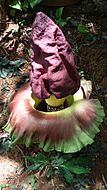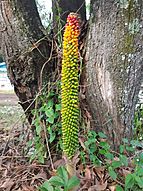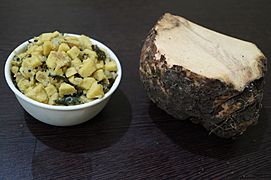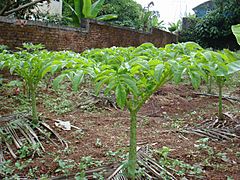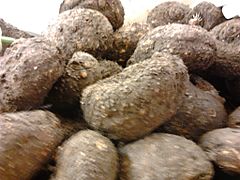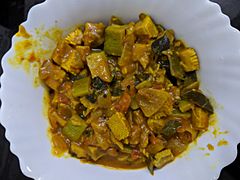Elephant foot yam facts for kids
Quick facts for kids Elephant foot yam |
|
|---|---|
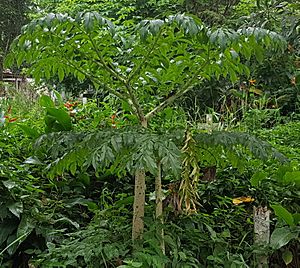 |
|
| A wild elephant foot yam plant from the Philippines | |
| Conservation status | |
| Scientific classification | |
| Genus: |
Amorphophallus
|
| Species: |
paeoniifolius
|
The Amorphophallus paeoniifolius, also known as the elephant foot yam or whitespot giant arum, is a special plant. It grows a large, underground stem called a corm, which is like a big potato. This plant is mostly found in warm, tropical places. You can find it in Africa, South Asia, Southeast Asia, and the Pacific islands.
People often grow elephant foot yam because it's a popular vegetable. It's used in many different types of cooking. Because it's so popular and grows well, farmers can sell it as a cash crop.
Contents
Where it Comes From
People in places like Island Southeast Asia, Mainland Southeast Asia, South Asia, New Guinea, Oceania, and Madagascar have used elephant foot yam as food for a long time. It was once thought that this plant first came from India. This is because it's used a lot there today.
However, a study in 2017 found something different. The elephant foot yams in India have less genetic variety than those in Island Southeast Asia. This means the plant likely started in Island Southeast Asia. From there, it spread west to Thailand and India. This led to the plant being grown by people in three different ways. It also traveled with the Austronesian migrations to Madagascar in the west. It also went east to New Guinea and Oceania. It might have even spread south to Australia on its own.
What it Looks Like
Its Flowers
This plant blooms once a year. This usually happens when the rainy season begins. A purple shoot comes out of the underground corm. This shoot then opens into a large, purple flower head.
The flower head has both male and female parts on the same plant. These parts are packed together in a cylinder shape. The top part of the flower makes a sticky liquid. This liquid has a strong, bad smell. This smell helps to attract insects that pollinate the plant. The middle part of the flower head has the male flowers. The bottom part has the female flowers.
On the first day the flower opens, the female parts are ready to receive pollen. The strong smell brings pollinating insects inside. Then, the flower head closes. This traps the insects for a night. This allows any pollen on the insects to be moved to the female parts.
On the second day, the female flowers are no longer ready for pollen. The male flowers then start to open. The flower head opens again. This lets the insects leave with new pollen on them. They can then carry this pollen to other flowers. This way, the plant avoids pollinating itself, which helps keep its genes strong.
About 24 to 36 hours after the flower first opens, the female flowers start to grow into bright red berries. The rest of the flower head begins to wilt. When the berries are ripe, they are red. They are not perfectly round, but more like an oval shape.
When the flowers are blooming, they also create heat. The whole flower dies after about five days.
How People Use It
As Food
-
Cultivated elephant foot yam from India
In West Bengal, India, and in Bangladesh, this yam is called Ol. People often eat it mashed or fried. It's also added to curries. Sometimes, it's used to make pickles or chips. In some homes, the green leaves and stems are cooked as vegetables too.
In Uttar Pradesh and Gujarat, it's known as Suran.
In Bihar, it's used in a curry called oal curry. It's also made into oal bharta (a mashed dish) or chokha. People also make pickles and chutney from it. One chutney is called Barabar chutney. It gets its name because it has equal amounts of mango, ginger, and yam.
In Chhattisgarh, it's called Zimmikanda. It's a popular curry and a special dish there.
In Southern India, especially in Kerala, it's known as Chena (ചേന). This root has been a part of people's meals for hundreds of years. In Tamil, it's called kaaraa karunai kizangu (காறாக்கருணைக் கிழங்கு) or chénaikkizangu (சேனைக்கிழங்கு). It's often served steamed with a traditional chutney. This chutney is made from green chili, coconut oil, small onions, and garlic. Curries made with yam are also common side dishes for rice. It can also be made into a thick mashed dish called masiyal (மசியல்). In the past, it was a main source of food during times of hunger, along with tapioca. The flower bud, before it blooms, is also used to make curry. Different parts of the flower can be used for various side dishes.
In the Philippines, it's called pongapong. The young leaves, stems, and corms are eaten as vegetables. They are also used to make desserts. They are cooked very well to remove tiny stinging crystals that the plant naturally has.
As Medicine
The elephant foot yam is also used in traditional Indian medicine. It is suggested as a remedy in three main Indian medical systems: Ayurveda, Siddha, and Unani. The underground corm is used in these systems for different health issues.
See also
 In Spanish: Patata de Telinga para niños
In Spanish: Patata de Telinga para niños



